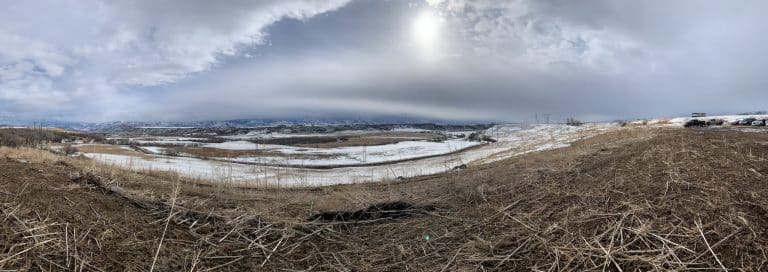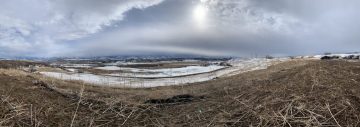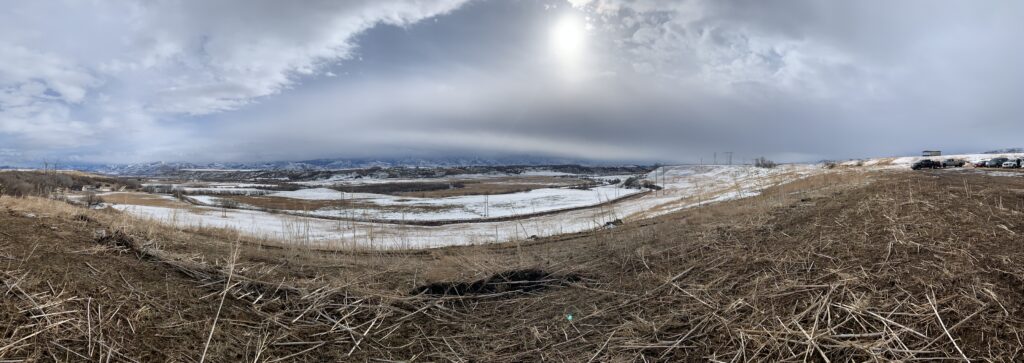Through my work with the BYU College of Education, I had the chance on Friday to not just attend the annual Bear River Massacre Commemoration ceremony, which remembers the largest single slaughter of Native people in American history, but to help document it.
This year is important because for the first time, the Northwest Band of the Shoshone Nation would be holding it on their own land, land they have been painstakingly buying back for decades. They will soon break ground and build an Interpretive Center on a butte which overlooks the stretch of the Bear River where the massacre occurred 158 years ago on January 29, 1863. But for now we meet on rich, wet soil covered in straw that still sticks to the souls of our shoes. It is sacred ground.
Previously the annual commemoration happened right off highway 91, just north of Preston, Idaho where the community, led by the Daughters of the Utah Pioneers (DUP), built a monument in 1932 and erected various plaques that called it the “Battle of Bear River,” denying the genocide. But Shoshone standard bearers like Mae Timbimboo Parry and descendants like her grandson Darren Parry have spent lifetimes researching and documenting the events that led to the slaughter, successfully getting the name changed from “Battle” to “Massacre.” What a difference a word can make.
As someone who knows the power of stories, I am moved to see how the Shoshone have reclaimed their narrative. Last week I told my friend Aimee how excited I was for the event. Aimee, a story collector like me, also has roots in Cache Valley and strong maternal links to the DUP. I knew she would understand the connections I felt. But what I didn’t anticipate was that she would reframe how I see the relationship between the events and people in the past and present and expand my notion of redemption. She said:
I have been rethinking my whole notion of what it means to “save the dead.” There is a deep connectedness that we have with each other across generations and time and races. And we have this obligation to keep seeking each other out and keep saving each other. And I think about my existence in 2021, as a descendant of people who displaced and wiped out and terribly treated so many Indigenous people. And so for me the idea of being able to be in that space is really holy and beautiful. And I am so glad that you are treating it like the ritual event that it is.
I carried her words around with me all day and saw the connectedness everywhere. There were drum songs and prayers offered up that pulled me to consider the timeline of the Shoshone being systematically driven and fenced off from their ancestral lands and hunting grounds. Later I will open up my Family Tree app and confirm my suspicions that these events coincide with the arrival of my paternal ancestors to Cache Valley from Scotland and Illinois. I can imagine my pioneer relatives thanking God for their freedom and the gift of the land, falling asleep every night thinking, “This is the place.” As one group claims space, another is displaced. I breathed in the smells of sage and cedar and wondered at the part that my people played in this sad story. It’s not about blame. I just need to understand how I am connected to the actions of my people.
One Shoshone tribal elder spoke about those who had been killed, how their spirits were here with us, dead but not departed. I listened while I took photographs of steam from the hot springs rising up over the snowy banks of the Bear River, swaying and dancing like a memory. Hot and cold. There then gone. I look up from my camera’s viewfinder but the mist people have faded.
Looking back and ahead simultaneously, the elder continued weaving their pain into power: “Step by step we move forward with faith and perseverance. Each obstacle we have encountered and overcome has made us stronger and more resilient to the future ahead. We are descendants of those survivors. We are the generations that are bound together.” Passed and still present.
Later that afternoon we gathered at the stone monument for the Daughters of Utah Pioneers ceremony where a new, more accurate plaque would be unveiled. I looked around judgmentally at the crowd of mostly white Mormon ladies. It takes me a minute to locate the source of my discomfort: they mirror my privilege and I resent the reflection.
My mother was part of the DUP when she lived in Cache Valley but arrived too late to have contributed money to these plaques. This filled me with unearned relief. I listened to the chapter head tell of her shock at realizing how horribly inaccurate the words on the monument were, and I wonder if my mom would have sprung into action and set about making things right. If I would have. My heart softened a bit. These women were reaching out to the survivors as they honored the dead, and trying to rewrite wrongs committed by hands that looked like their own, but were not their own. It was an imperfect offering. Parts made me cry; parts made me cringe.
Darren Parry, historian and former tribal chair represented his people as the final speaker. He praised the women for pushing for the correction and yet expressed his dismay that the most offensive of the plaques had been removed. He said he would prefer that it stand in contrast to the new one, to show who we were but also that we are “getting better.” I nodded my head but I understand. I do not want my past mistakes to remain on display, no matter how noble the purpose. I am more DUP than I care to admit. And they have done a hard thing, owning the sins of their foremothers. Parry, the ultimate bridge builder, moves forward and acknowledges the women for their part in redeeming the monument, and I wonder if that helps redeem their predecessors. He is honest but not judgmental. Their offering is sufficient.
One of the missions of the Church of Jesus Christ of Latter-day Saints is to redeem the dead, something we traditionally take to mean performing vicarious temple rites. But Aimee has parted the veil for me and I see there are many ways of saving people. We went to Preston to witness the Shoshone stake their claim to the land, past, present and future, to tell the truth and make sure it’s written on the monuments, in history books, and in the hearts of everyone who listens. There is redemption in this. The truth sets people free. And the people I watched Friday were not just freeing their own. They extend grace to the offenders of the past and those of us today. Whether or not we’ve earned it, the offer of peace is there.
I have made an offering too. With every click of my camera shutter, I became a witness. With every photo I share, I testify of truth. With these words that I write, I say amen. Amen.





14 Responses
Heather, this is gorgeous. I’m so glad you wrote this out and gave us all a small glimpse into such a sacred space. I love the reframing of redeeming the dead, too – it’s giving me a lot to think about.
Thank you! And Aimee is wicked wise.
I love the truthful but kind tribal representative. We certainly could use more redemption and less revenge in our world. Thank you for taking time to document and share.
This piece is a prayer and a model of the repentance process and an expounding of theology that makes my heart grow. Your model and Aimee’s wise words demonstrate how to be kinder to myself and my ancestors while also holding my people and me accountable to have honest relationships with the indigenous ancestors and descendants (survivors) we drove out to live on this land. I live 10 minutes from an “Indian School;” this demonstrates with eloquent writing and heartfelt repentance how I can start my work to redeeming the dead on the indigenous land I live on. Thank you, thank you.
Loved this, Heather. I’ve written a yet-to-be-published novel about my polygamous ancestors who lived in Cache Valley. As part of my research I went to the monument site and definitely felt that the spirits of the dead still haunt the place. I hope they will find peace through the current efforts to reclaim the land.
I would love to read that. I think reclaiming land is bringing heal on both sides of the veil.
I think this may be one of the most important things I have read in a long time. Beautiful and honest. I am thinking in a whole new way about “redeeming the dead” and the work I can do. I am so glad you were able to take part in such a sacred and vital day. We need to do more of this type of redemptive work. I know I do.
I’m like Lisa, I feel this to be one of the most important things I’ve read in recent memory. Thank you so much.
Such a beautiful reframing of saving the dead. Thank you for writing this.
Wow Heather! What a beautifully written piece. Thank you for bringing us along on your journey.
Heather, this is an exquisite and evocative piece of writing. Thank you so much for taking us all along with you and allowing us to join you as witnesses to those powerful events. This has made me think deeply about how integrally linked witnessing is to mourning, and it has made me turn ideas over in my head about how much healing only comes when people are willing to exercise humility and grace. I just loved this – it was a beautiful, beautiful sermon. Thank you.
I recently read a history book in which the following is quoted from a reconciliation conference in 1997 in which the Catholic Church acknowledged “its oppressive role against the Waldensian Church and community.” (Centuries earlier it had tried to totally exterminate those “heretics.”) This was from a speech given in Rome by the Archbishop of Perugia.
“As far as we are concerned, history is what it is. We can neither cancel it nor pretend that it did not happen. We can, however, take responsibility for what happened and tend the wounds in our memories, first by recognizing then and then, when necessary, by asking and giving forgiveness, and by following Jesus’ teaching on reconciliation.”
What a powerful quote!! Thank you for sharing that with me. I don’t understand why so many institutions (including religions) only see weakness in apology whereas I see strength.
That is beautiful!